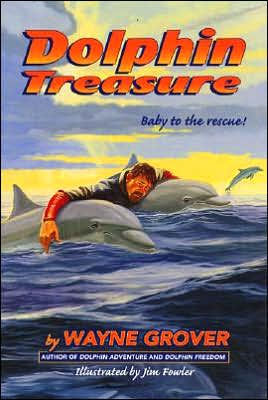

Paperback(Reprint)
-
SHIP THIS ITEMTemporarily Out of Stock Online
-
PICK UP IN STORECheck Availability at Nearby Stores
Available within 2 business hours
Related collections and offers
Overview

Product Details
| ISBN-13: | 9780380732531 |
|---|---|
| Publisher: | HarperCollins |
| Publication date: | 06/05/2001 |
| Series: | Harper Trophy Bks. |
| Edition description: | Reprint |
| Pages: | 80 |
| Product dimensions: | 5.12(w) x 7.62(h) x 0.16(d) |
| Lexile: | 910L (what's this?) |
| Age Range: | 8 - 12 Years |
About the Author
Jim Fowler enjoys kayaking, camping, and wildlife viewing. He is the illustrator of many books for young readers, including Dolphin Adventure, Dolphin Freedom, and Dolphin Treasure by Wayne Grover. He lives in Juneau, AK.
Read an Excerpt
Chapter One
Sunken Spanish
Treasure
I scanned the water in all directions, looking for my dolphin friend. Since I had saved his life by cutting a large fishhook from his tail when he was a baby, he had become my companion whenever I was at sea, diving or looking for old Spanish treasure on the seafloor.
Like a faithful and loving dog, Baby followed me and my diving friends whenever we took our boat out to the clear water of the Atlantic Ocean, near Jupiter, Florida.
He and his dolphin family'mother, father, one brother, and two sisters'usually joined us as soon as we pulled out of the Jupiter Inlet,where the landlocked Intracoastal Waterway connects to the open sea.
I have no doubt that dolphins have good memories because within weeks after I had saved Baby's life, his family started following our boat whenever we sailed in the ocean.
Today Amos and I, along with Jack Riley, another diver, almost decided not to go looking for treasure at the site we had been working for several weeks. The weather looked threatening even though the sun broke through the clouds, making beautiful rays in the early dawn light.
Amos, at the wheel, knew the Florida weather better than anyone, and he didn't like what he was seeing as he steered the boat through the inlet and headed out to the open sea. He gunned the engines to attack the white-capped waves.
The outgoing tide of the inland waterway rushed to join the sea in a white-capped collision. Our thirty-four-foot boat, Treasure Hunter, was right in the middle of this treacherous area. Amos struggled to keep the boat fromgoing up so steeply that it would flip over. Weclimbed the gigantic waves at the inlet's mouth until finally we cleared the area and entered the Atlantic.
It was early January, and the sea was rough. The wind sheared the wave tops off, forming little rainbows above each one as it marched shoreward. Through the early-morning mist I looked to see if dolphin fins were breaking the surface as the dolphins sped along, but there were none today.
Our diving site was off the coast three miles south of Jupiter. We were working to recover gold, silver, and jewels from an old Spanish treasure galleon that had sunk along with nine other ships during a hurricane in July 1715.
The southeast coast of Florida is called the Treasure Coast for good reason. Along its shore lie the remains of dozens of Spanish treasure ships that were sunk over a three-hundred-year period. Many of them were caught in raging hurricanes that ripped them apart. Years of changing tides and storms had buried the ships. By using hand-held metal detectors that could locate objects hidden under the sand, Amos and I had discovered one of the old wrecks, and we were working to recover its treasure.
Baby had been at my side when I finally was able to ascertain the age of the old shipwreck we would be exploring again that day. I had been searching the seabed with a metal detector when suddenly I heard a loud whine in my earphone.
Baby responded with rapid clicks of excitement. He knew the sound meant I would stop to dig in the sand, and he loved to help.
As we swam slowly around, searching for metal, I was amazed to see an old anchor that weighed perhaps two tons, then another one. And nearby I saw a row of cannon lying half buried in the sand. We had found the ship's final resting place.
I used my hand to clear the sand away from one of the cannon so I could see under it. It was slow going until Baby joined in.
He became a dolphin digging machine. He hovered over the cannon and rapidly fluttered his big tail up and down, while holding himself stationary with his side flukes. Within seconds the cannon lay completely exposed. Baby watched me intently as I examined the encrusted cannon. Clicking like a sonar, he aimed his nose at the cannon as if to see for himself why I was so interested. When he clicked close to me, I could feel his sound waves hit my body. His sonar was better than the best ship's instrument.
On the underside of the cannon was a big clump of blackish material. I took a small hammer from my belt and hit it. It fell apart, spilling silver coins onto the sand.
I held one up and looked closely at it. On one side was a Spanish cross; on the other a royal shield with the date clearly visible: 1714. I looked at a second coin: 1713. I had found proof at last of the ship's identity. Our wreck was one of ten ships that had gone down in a hurricane on July 31, 1715. It could not have belonged to any other Spanish fleet because there was no record of any ships lost for several years before or after the 1715 tragedy.
Dolphin Treasure. Copyright © by Wayne Grover. Reprinted by permission of HarperCollins Publishers, Inc. All rights reserved. Available now wherever books are sold.